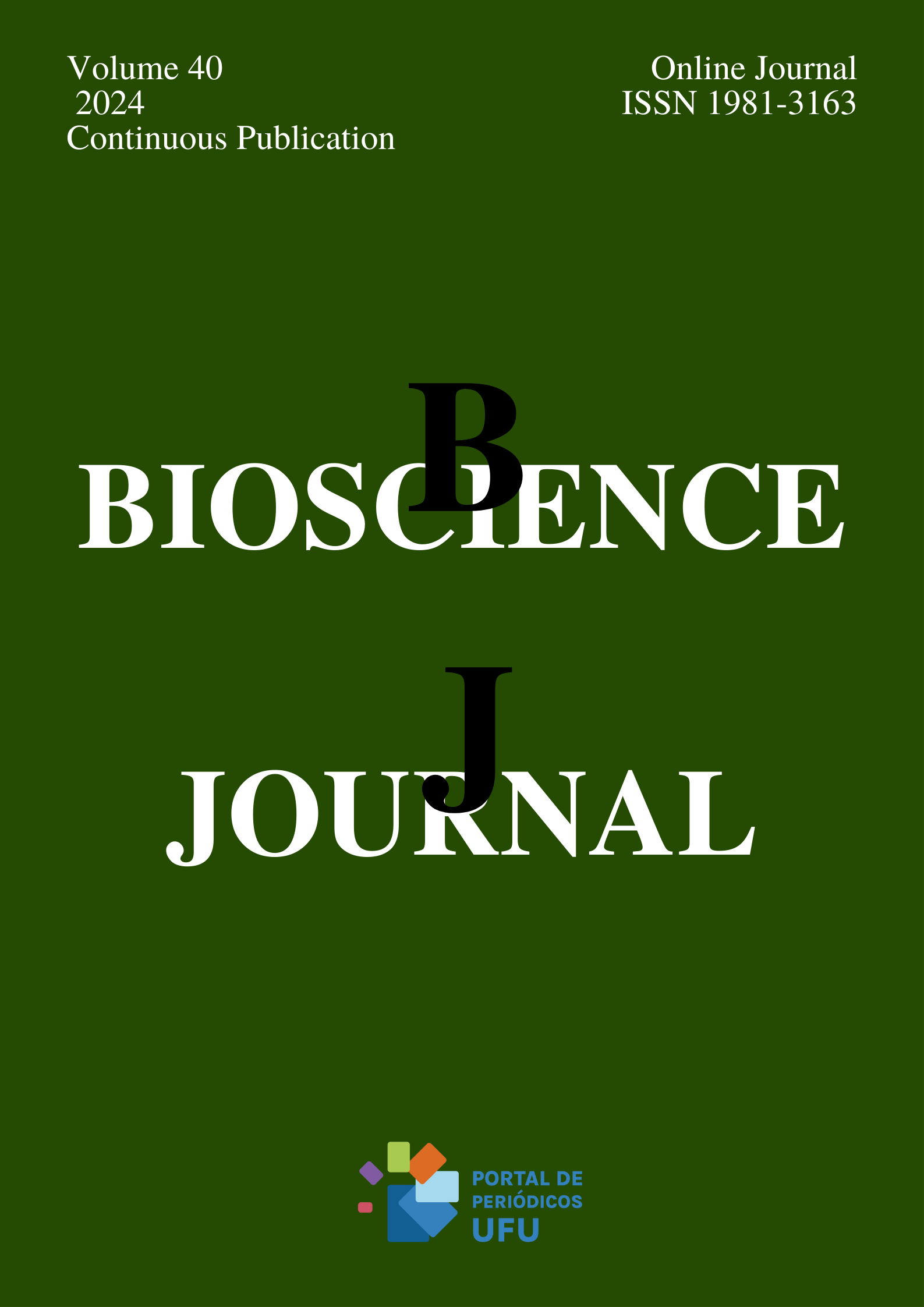Effect of mite-specific subcutaneous immunotherapy on patients with allergic rhinitis
DOI:
https://doi.org/10.14393/BJ-v40n0a2024-70819Keywords:
Allergic rhinitis, Immunoglobulin E. Mite, Subcutaneous immunotherapy.Abstract
This study analyzed the effect of mite-specific subcutaneous immunotherapy (SCIT) on patients with allergic rhinitis (AR). We enrolled 98 AR patients visiting our hospital from April 2017 to April 2019 and grouped them in a random number table. The control group (n=49) received conventional treatment for three years. The SCIT used a standardized mite allergen injection for the experimental group (n=49) for three years. The study compared total nasal symptom score (TNSS), daily medication score (DMS), total combined score (TCS), visual analog scale (VAS) score, mini-rhinitis quality of life questionnaire (MiniRQLQ) score, and serum immunoglobulin E (sIgE) level before and after treatment. The overall response rate was higher in the experimental group than in the control group (59.18% vs. 30.61%, p<0.05). After treatment, the experimental group had lower values for TCS and VAS score (p<0.05); motion score; practical problems; nasal, ocular, and other symptoms (p<0.05); and sIgE, Dermatophagoides pteronyssinus (Dp)-sIgE, and Dermatophagoides farinae (Df)-sIgE levels (p<0.05) than the control group. The sIgE, Dp-sIgE, and Df-sIgE levels were lower in the effective group than in the ineffective group (p<0.05). The areas under the ROC curves of IgE, Dp-sIgE, and Df-sIgE and their combination for predicting the therapeutic effect of mite-specific SCIT on AR were 0.839, 0.779, 0.814, and 0.903, respectively. Mite-specific SCIT relieved clinical symptoms and improved the quality of life of AR patients, probably by decreasing the IgE expression level.
References
ALVARO-LOZANO, M., et al. EAACI Allergen Immunotherapy User's Guide. Pediatric Allergy and Immunology. 2020, 31 Suppl 25, 1-101. https://doi.org/10.1111/pai.13189
AUN, M.V., et al. Diphteria-tetanus-pertussis vaccine reduces specific IgE, inflammation and remodelling in an animal model of mite-induced respiratory allergy. Vaccine. 2020, 38(1), 70-8. https://doi.org/10.1016/j.vaccine.2019.09.095
BAI, J. and TAN, B.K. B Lineage Cells and IgE in Allergic Rhinitis and CRSwNP and the Role of Omalizumab Treatment. American Journal of Rhinology Allergy. 2023, 37(2): 182-92. https://doi.org/10.1177/19458924221147770
BESH, L., SLYUZAR, Z. and MATSYURA, O. Optimization Of Allergen-Specific Immunotherapy In Children With Bronchial Asthma: Selection Features, Patient Monitoring And Efficacy. Georgian Med News. 2020, 306(306), 67-72. PMID: 33130649.
BOONPIYATHAD, T., et al. Der p 1-specific regulatory T-cell response during house dust mite allergen immunotherapy. Allergy. 2019, 74(5), 976-85. https://doi.org/10.1111/all.13684
BOUSQUET, J., et al. Next-generation Allergic Rhinitis and Its Impact on Asthma (ARIA) guidelines for allergic rhinitis based on Grading of Recommendations Assessment, Development and Evaluation (GRADE) and real-world evidence. Journal of Allergy and Clinical Immunology. 2020, 145(1), 70-80.e3. https://doi.org/10.1016/j.jaci.2019.06.049
CHENG, L., et al. Chinese Society of Allergy Guidelines for Diagnosis and Treatment of Allergic Rhinitis. Allergy, Asthma & Immunology Research. 2018, 10(4), 300-53. https://doi.org/10.4168/aair.2018.10.4.300
CHINESE JOURNAL OF OTOLARYNGOLOGY HEAD AND NECK SURGERY EDITORIAL BOARD, RHINOLOGY GROUP, CHINESE MEDICAL ASSOCIATION OTOLARYNGOLOGY HEAD AND NECK SURGERY SOCIETY. Chinese Guidelines for diagnosis and treatment of allergic rhinitis (2022, Revised edition). Chinese Journal of Otolaryngology Head and Neck Surgery. 2022, 57(2), 392-404. https://doi.org/10.3760/cma.j.cn115330-20211228-00828
DURHAM, S.R. and SHAMJI, M.H. Allergen immunotherapy: past, present and future. Nature Reviews Immunology. 2023, 23(3), 317-28. https://doi.org/10.1038/s41577-022-00786-1
FENG, M., ZENG, X. and LI, J. House dust mite subcutaneous immunotherapy in Chinese patients with allergic asthma and rhinitis. Journal of Thoracic Disease. 2019, 11(8), 3616-25. https://doi.org/10.21037/jtd.2019.06.35
GELLRICH, D., et al. De novo sensitization during subcutaneous allergen specific immunotherapy - an analysis of 51 cases of SCIT and 33 symptomatically treated controls. Science Reports. 2020, 10(1), 6048. https://doi.org/10.1038/s41598-020-63087-4
GIOACCHINO, M., et al. Real-Life Effectiveness of Subcutaneous Immune Therapy with Carbamylated Monomeric Allergoids on Mite, Grass, and Pellitory Respiratory Allergy: A Retrospective Study. Japanese Clinical Medicine. 2022, 11(24), 7384. https://doi.org/10.3390/jcm11247384
HAMED, A., et al. Nasal IgE production in allergic rhinitis: Impact of rhinovirus infection. Clinical & Experimental Allergy. 2019, 49(6), 847-52. https://doi.org/10.1111/cea.13372
HESSE, L., et al. Subcutaneous immunotherapy with purified Der p1 and 2 suppresses type 2 immunity in a murine asthma model. Allergy. 2018, 73(4), 862-74. https://doi.org/10.1111/all.13382
HUANG, H.H., et al. Efficacy comparison and safety analysis of subcutaneous specific immunotherapy with standardized house dust mite allergen in patients with single and multiple allergic rhinitis. Zhonghua Yu Fang Yi Xue Za Zhi. 2022, 56(6), 774-83. https://doi.org/10.3760/cma.j.cn112150-20220120-00071
LIU, Z., et al. Predictive methods for efficacy of house dust mite subcutaneous immunotherapy in allergic rhinitis patients: a prospective study in a Chinese population. Internet Forum Allergy Rhinology. 2020, 10(3), 314-9. https://doi.org/10.1002/alr.22508
SHAMJI, M.H., et al. Diverse immune mechanisms of allergen immunotherapy for allergic rhinitis with and without asthma. Journal of Allergy and Clinical Immunology. 2022, 149(3), 791-801. https://doi.org/10.1016/j.jaci.2022.01.016
VALERO, A., et al. Efficacy of subcutaneous house dust mite immunotherapy in patients with moderate to severe allergic rhinitis. Immunotherapy. 2022, 14(9), 683-94. https://doi.org/10.2217/imt-2021-0353
WANG, C., et al. Chinese Guideline on Allergen Immunotherapy for Allergic Rhinitis: The 2022 Update. Allergy, Asthma & Immunology Research. 2022, 14(6), 604-52. https://doi.org/10.4168/aair.2022.14.6.604
XUE, J.R., et al. Observation and analysis of systemic reactions to house dust mite subcutaneous immunotherapy in 362 patients with allergic rhinitis. Zhonghua Er Bi Yan Hou Tou Jing Wai Ke Za Zhi. 2020, 55(5), 445-51. https://doi.org/10.3760/cma.j.cn115330-20200426-00333
Downloads
Published
Issue
Section
License
Copyright (c) 2024 Guoyan Sun, Shuangba He, Qingxiang Zhang

This work is licensed under a Creative Commons Attribution 4.0 International License.





